Evaluating Curved Monitors for Professional Use
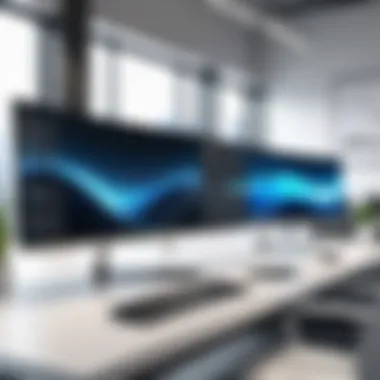
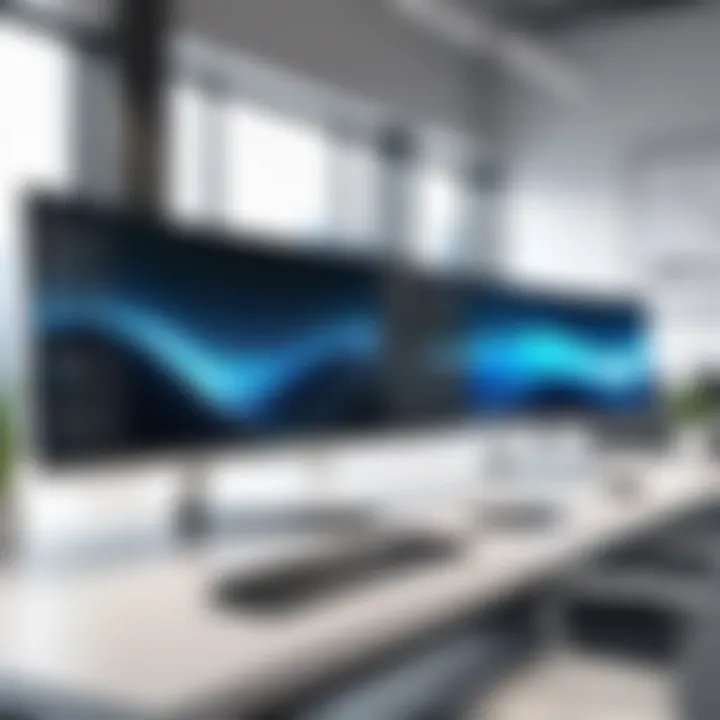
Intro
In the ever-evolving landscape of professional technology, the choice of display can significantly impact both productivity and comfort. Curved monitors have gained popularity for their unique design and potential advantages over traditional flat screens. This section introduces the core aspects of curved monitors in professional settings, focusing on their ergonomic benefits, visual performance, and overall utility.
Curved monitors stand out for their ability to provide an immersive experience. The curvature of the screen is designed to match the natural field of view, reducing eye strain during extended periods of use. This feature becomes particularly important in work environments where long hours in front of a screen are the norm.
As we delve deeper into the effectiveness of curved monitors, it is essential to consider various factors that influence their adoption in professional settings. These include:
- Ergonomics: How the design promotes better posture and reduces physical discomfort.
- Productivity: The impact on focus and efficiency in completing tasks.
- Visual Performance: Differences in clarity, color representation, and viewing angles compared to flat screens.
- Technological Advancements: Recent innovations that enhance the capabilities of curved displays.
Through a comprehensive exploration, this article aims to equip IT professionals and tech enthusiasts with valuable insights that can facilitate informed purchasing decisions. Understanding the advantages and limitations of curved monitors will enable users to select the most appropriate device for their specific work environment.
As we progress, various dimensions of performance will be analyzed, ultimately revealing whether a curved display is indeed advantageous for professional use.
Prelims
In the context of professional environments, the choice of monitor significantly impacts productivity and user experience. As technological advancements continue to evolve, curved monitors have gained traction as a potential game-changer in the workspace. This article delves into the various facets of curved monitor technology and its implications for users in professional settings.
Curved monitors are designed to provide a more immersive viewing experience than their flat counterparts. This is critical for professionals who spend extended hours in front of screens, such as graphic designers, data analysts, and programmers. The unique curvature of these displays aims to enhance visual comfort and reduce fatigue, addressing common issues associated with prolonged screen time.
Understanding the effectiveness of curved monitors involves evaluating several key elements:
- Ergonomics: A curved screen can help maintain a neutral posture, potentially lessening strain on the neck and back.
- Productivity: The ability to multitask on a single display without the need for multiple monitors can streamline workflows.
- Visual Performance: Color accuracy and contrast play a crucial role, especially for visual-based professions.
- Design Considerations: How these monitors fit within office layouts and aesthetics can influence purchasing decisions.
As this article proceeds, we will explore these aspects in detail. Our aim is to equip IT professionals and tech enthusiasts with the insights necessary to evaluate whether a curved monitor is a worthwhile investment for enhancing their work environment.
Understanding Curved Monitor Technology
Curved monitors represent an evolution in display technology that aims to enhance the viewing experience, particularly in professional settings. They achieve this by wrapping the screen around the viewer’s field of vision. This design principle is pivotal as it addresses key aspects such as immersion, visual focus, and even ergonomics. When one considers the demands of work environments—where prolonged screen time is common—understanding the integral components of curved monitors becomes essential.
Definition and Mechanics
Curved monitors are defined by their concave design, which differs from traditional flat screens. The curvature range varies, often measured by the "R" value. For example, a 1800R curve means the screen would form a circle with a radius of 1,800 millimeters. The mechanics behind curved monitors involve their display panels which use advanced technologies to achieve a more panoramic view, reducing distortion at the edges and enhancing depth perception. This type of design aims to create a more immersive workspace, where details appear sharper and more vivid.
Types of Curved Monitors
Differences in technology can significantly impact the user’s experience with curved monitors. The principal types include:
VA (Vertical Alignment)
Vertical Alignment (VA) panels are well-regarded for their excellent contrast ratios. This characteristic stems from the arrangement of liquid crystals within the display. VA panels are capable of producing deeper blacks, which can enhance the overall visual performance in darker environments. Their good color reproduction makes them suitable for tasks that require attention to detail, such as graphic design.
However, VA panels may exhibit slower response times compared to other panel types, which could impact fast-paced gaming or highly dynamic presentations. In a professional setting, this might impact users who require seamless motion.
IPS (In-Plane Switching)
In-Plane Switching (IPS) panels are another popular option. Their strength lies in superior color accuracy and wider viewing angles. This means images retain their quality when viewed from different positions. For professionals working within design, video editing, or in any field where color fidelity is essential, IPS panels represent a significant advantage.
Nevertheless, IPS panels generally have lesser contrast ratios compared to VA panels, which could become a downside in low-light conditions. Users must weigh color precision against contrast capabilities when selecting an IPS curved monitor for work purposes.
TN (Twisted Nematic)
Twisted Nematic (TN) panels are often recognized for their rapid response times. This feature makes them a favored choice for gaming, but they also find utility in professional settings needing quick visual feedback. The fast refresh rates can translate to smooth visual transitions, which is beneficial in tasks involving real-time data.
Nevertheless, TN panels have limited color reproduction and narrower viewing angles, which may detract from their effectiveness in tasks requiring high-fidelity colors. Users working in environments with a focus on visual details may find this aspect a limitation.
"Choosing the right type of curved monitor can significantly influence your productivity and comfort during long hours of use."
Ergonomics and User Comfort
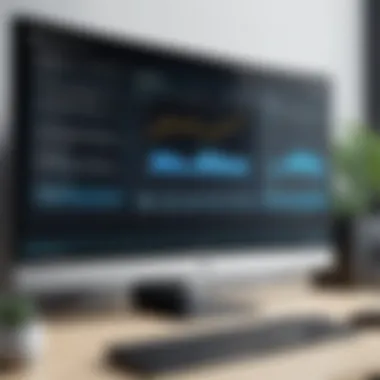
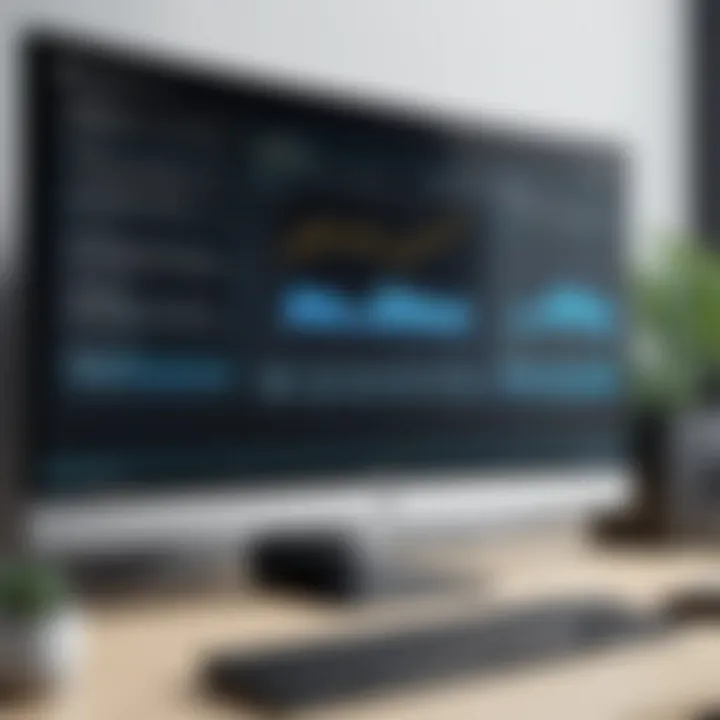
Ergonomics plays a crucial role in the design and effectiveness of workplace technology, particularly for curved monitors. In professional environments, the integration of ergonomic principles can significantly influence user comfort, resulting in a more productive workspace. When we discuss ergonomics and user comfort, we are looking at how the design of curved monitors promotes better posture, minimizes physical strain, and enhances overall productivity.
Posture and Viewing Angles
The design of curved monitors is meant to optimize viewing angles. Unlike flat monitors, curved screens wrap around the viewer's field of vision, reducing the amount of head movement required. This design can help maintain a more neutral posture. Ideally, the top of the screen should be at eye level, and the viewer should sit at a distance that avoids straining the neck or back.
Proper posture while using monitors is essential. It can help individuals avoid musculoskeletal disorders, which are common in office environments. For instance, the typical 90-degree angle at the elbow while typing can be better maintained with the right monitor placement.
"Studies show that maintaining proper posture while working can lead to a 40% reduction in back pain complaints among users."
In addition, a curved monitor's design can prevent glare from bright overhead lights, making it easier to focus on the screen without rerouting the eyes frequently. Users can enjoy a more immersive experience, as the edges of the screen bring content closer to the periphery of their vision. This is particularly beneficial in a multi-monitor setup, where flat screens can create visual fatigue from constant shifting of gaze.
Potential Strain Reduction
Curved monitors also hold the potential for significant reductions in visual and physical strain. When used correctly, they can help to alleviate several common workplace complaints such as eye fatigue and neck strain.
Benefits of potential strain reduction includes:
- Reduced glare: The curvature can minimize reflections and glare, enabling users to maintain focus for longer periods without discomfort.
- Less eye movement: Because the entire screen is slightly angled, the need to move the eyes laterally is minimized, making it easier to track information displayed.
- Comfortable viewing distance: Curved screens allow for adjustments in viewing distance, accommodating individuals with varying eyesight and preferences.
These ergonomic advantages make curved monitors especially appealing for professionals who spend long hours in front of a display. By reducing the physical and visual strain associated with flat screens, users may not just work more effectively but also sustain their comfort throughout the day.
In summary, the aspects of ergonomics and user comfort with curved monitors are crucial in professional environments. By promoting better posture and reducing strain, these devices can support a healthier workplace, ultimately enhancing productivity.
Impact on Productivity
The impact of curved monitors on productivity is a crucial aspect that deserves thorough examination. In professional settings, efficiency is paramount. Curved monitors promise enhancements that can translate into measurable gains for users. By providing a more immersive experience and facilitating multitasking, these displays offer unique advantages over traditional flat monitors.
Multitasking Capabilities
Curved monitors are particularly advantageous for multitasking. The structure of a curved screen allows for improved peripheral visibility. This feature is essential when users are handling multiple applications simultaneously.
- Wider Field of View: The curvature increases the field of view, enabling users to position more windows on their desktop without excessive head turning.
- Reduced Visual Clutter: With the screen's design holding content closer to the viewer's line of sight, it minimizes the strain associated with scanning multiple screens or windows.
- Enhanced Focus: Users report that curved displays help maintain orientation, making it easier to stay focused on assigned tasks. This leads to a quicker turnaround time for projects as fewer disruptions occur when shifting between tasks.
Research indicates that professionals working with curved displays often experience a more natural workflow. Studies suggest that such users are able to manage up to 30% more tasks than those using flat monitors. Overall, the design fosters a productive environment that aligns well with fast-paced work demands.
Focus and Immersion
Focus and immersion are two additional factors where curved monitors shine. The design of these displays creates a more enveloping visual experience.
- Improved Depth Perception: This can enhance the perception of depth in visual tasks, which can be useful in graphic design, video editing, or any profession that requires precise visual acuity.
- Reduced Distractions: Since the monitor wraps around the user’s field of vision, external distractions become less prominent. For many users, this leads to improved concentration on their work.
- Emotional Engagement: The immersive quality elevates the user’s emotional engagement with the content. This can foster a deeper connection to projects, which is key in creative fields.
Data shows that many professionals feel more "involved" with their work when using curved monitors. This factor alone can encourage a higher quality of output. As a result, these displays are compelling choices for environments that require sustained attention and creativity.
"Curved monitors can dramatically change how users experience their work, enhancing both efficiency and engagement."
In summary, the impact of curved monitors on productivity should not be underestimated. Their benefits in multitasking and focus and immersion significantly contribute to a professional's ability to perform tasks efficiently and effectively.
Visual Performance Considerations
Visual performance is a cornerstone of any professional environment, deeply influencing productivity and user comfort. Curved monitors offer a unique visual experience that can enhance how users interact with their work. In examining this topic, we focus on several critical elements, particularly color accuracy, contrast and response times, and flicker and eye strain. Understanding these aspects can serve as a guide for IT professionals and tech enthusiasts when deciding about monitor investments.
Color Accuracy
Color accuracy plays a vital role in many professional fields, such as graphic design, video editing, and any task where color representation is crucial. Curved monitors, like those from Dell and Samsung, can provide superior color reproduction compared to traditional flat screens. The range of colors displayed can be broader, with enhanced depth often attributed to the curvature of the screen.
Users should consider monitors that specifically detail their color gamut, such as Adobe RGB or sRGB coverage. This is essential for creative professionals who depend on precise color matching. Moreover, curved monitors often reduce the chances of color distortion, as the radial design can maintain consistency across the screen.
Contrast and Response Times


Contrast ratio is another significant factor that impacts visual performance. Curved monitors generally exhibit higher contrast ratios, allowing for deeper blacks and brighter whites. This is particularly useful in dimly lit environments, reducing the strain on eyes when assessing details in darker images or videos.
Response times are also crucial. A lower response time means less motion blur, which can be particularly beneficial for tasks requiring rapid movements, such as gaming or real-time animation work. Many high-end curved monitors boast response times as low as 1ms, which competes favorably with flat monitors. Consequently, a monitor that combines good contrast and quick response allows for a more engaging and efficient workflow.
Flicker and Eye Strain
Eye strain remains a pressing concern among professionals who spend extended hours in front of screens. Curved monitors traditionally have an advantage here as they are designed to minimize glare and reflected light.
Flicker is often an unrecognized problem in various displays. Monitors that use PWM (Pulse Width Modulation) for brightness adjustment can cause flicker issues, leading to fatigue. When selecting a curved monitor, it's wise to look for models that offer flicker-free technology, which many manufacturers now incorporate to enhance user comfort.
"Professional work requires displays that not only offer good visuals but also protect users from long-term health issues like eye strain."
Choosing a monitor with these features will significantly improve visual performance and comfort, ensuring a more productive experience.
Overall, understanding how color accuracy, contrast, response times, and flicker relief contribute to visual performance helps professionals make informed decisions about their equipment. These considerations are essential for creating a workspace that promotes efficiency and health.
Comparative Analysis with Flat Monitors
The comparative analysis between curved and flat monitors is essential in understanding their respective roles in professional environments. Considering the growing adoption of curved displays, it is critical to evaluate their advantages and limitations to make well-informed purchasing and usage decisions. This section focuses on specific elements such as usability, user experience, and how each type of monitor impacts productivity and comfort.
Advantages of Curved Displays
Curved monitors offer unique advantages that can enhance the overall user experience in professional settings. Here are some noteworthy benefits:
- Immersive Experience: Curved monitors create a wrap-around effect, making users feel more engaged. This is particularly beneficial in creative fields such as graphic design or video editing, where immersive visuals help in better content creation.
- Reduced Distortion: They typically provide a more uniform viewing distance compared to flat monitors. This can help minimize distortion at the edges of the screen, which is often more pronounced in flat designs.
- Enhanced Field of View: The natural curvature can enhance peripheral vision, allowing for easier multitasking and a broader workspace without the need for multiple screens. This eases the cognitive load during complex tasks.
- Better Depth Perception: Users may experience improved depth perception. This can be pivotal when examining intricate details in design or data analysis, leading to improved accuracy and quicker decision-making.
- Aesthetic Appeal: Curved displays often have a modern design that many users find appealing. This can enhance the overall look of a workspace, making it feel more sophisticated or professional.
Limitations of Curved Monitors
However, curved monitors also come with inherent limitations that require careful consideration:
- Viewing Angle: Curved monitors may not provide the same optimal viewing angles as flat monitors. In multi-user scenarios, specifically a team around one monitor, image quality and color accuracy can suffer.
- Cost: Generally, curved monitors tend to be pricier than their flat counterparts. For budget-conscious businesses, this can be a significant factor.
- Space Requirements: Their design often requires more desk space due to their curvature. This can be a challenge in compact work environments.
- Potential for Glare: Depending on room lighting, curved screens may reflect more glare, which can be distracting or even harmful to productivity.
- Adjustment Period: Users transitioning from flat displays may require time to adapt to the curved screen. This initial discomfort can impact workplace efficiency until users become accustomed.
While curved monitors offer immersive experiences, they do come with trade-offs. It's crucial to assess how these features align with your specific work needs.
Balancing these advantages and limitations facilitates a deeper understanding of how curved monitors can be effectively integrated into professional environments. Each workplace has unique demands, and these factors should guide individuals or IT departments in selecting the most suitable display technology.
Design Considerations for Workspaces
Understanding the design considerations for workspaces is essential for maximizing the benefits of curved monitors in professional settings. These considerations encompass both practical and aesthetic elements that can significantly impact a user's experience. Proper arrangements can enhance ergonomics and optimize productivity while ensuring that the workspace reflects a professional image.
Desk Space and Arrangement
When selecting a curved monitor, one must consider desk space and the overall arrangement of the workspace. Curved monitors typically occupy more surface area than their flat counterparts. Users should assess their available space and how the monitor will fit within it. The depth of the desk is particularly important, as users need sufficient distance from the screen to minimize eye strain. A distance of 70 to 80 centimeters from the screen is often recommended.
Moreover, the arrangement of the monitor relative to other devices is also crucial. For instance, if one uses a laptop alongside the monitor, positioning should facilitate easy access and reduce strain from frequent head and neck movements. This setup enables multitasking and creates a seamless workflow.
Key considerations for desk space include:
- Width and Depth: Ensure the monitor size suits the desk dimensions.
- Adjacencies: Keep frequently used items within reach to improve efficiency.
- Cable Management: Optimal layout helps reduce clutter from cables, which may also distract and detract from professional aesthetics.
"Effective workspace design can drastically enhance productivity and user comfort."
Aesthetic Integration and Style
Aesthetics play a significant role in modern workplaces. When choosing a curved monitor, one must not overlook how it integrates with the overall office design. An appealing monitor can enhance the workspace's visual appeal and contribute to a more inviting atmosphere. This appeal can be particularly beneficial in client-facing environments.
Curved monitors come in various designs and color schemes. Selecting a model that complements existing furniture and decor can lead to a more cohesive look. For example, opting for a sleek black monitor might match well with contemporary office styles, while warmer colors may blend into a more traditional setting.
Additionally, consider the monitor's bezel size and finish. Thinner bezels often create a more modern aesthetic, while matte finishes can reduce glare and improve the overall viewing experience during meetings or collaborative work.
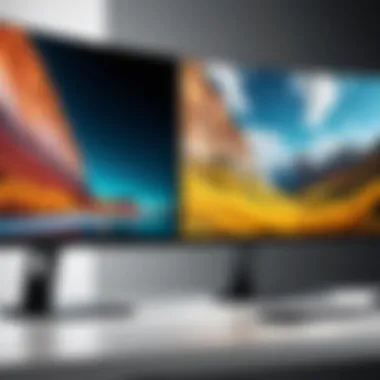
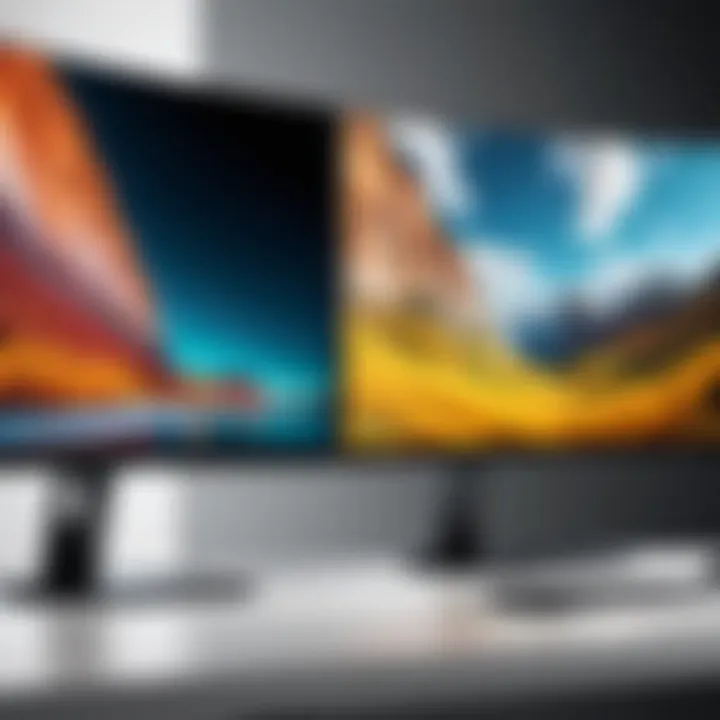
Here are some points for consideration regarding aesthetic integration:
- Color Scheme: Align monitor colors with the workplace theme.
- Design Compatibility: Choose monitors that match the office furniture style.
- Ergonomic Accessories: Invest in stands or mounts that enhance both aesthetics and function.
Reader Experiences and Feedback
Understanding reader experiences and feedback is vital when evaluating the effectiveness of curved monitors in professional environments. Feedback from users provides real-world insight into how these devices perform over extended periods. It can reveal not only the benefits but also the potential drawbacks that may not surface in technical specifications or marketing materials. Users' opinions contribute significantly to shaping the perception of curved monitors in the market.
In this section, we will delve into two main aspects of reader feedback: testimonials from professionals and common issues raised by users. Each of these areas highlights significant elements regarding the usability, comfort, and overall satisfaction derived from curved monitors. By listening to professionals actively using these devices, IT professionals and tech enthusiasts can make informed decisions, ensuring their investments align with workplace needs and expectations.
Testimonials from Professionals
Testimonials from professionals who utilize curved monitors in their workspaces provide a rich array of insights. Many users commend the immersive experience offered by these monitors. This immersion is particularly beneficial in fields such as graphic design, video editing, and gaming where color accuracy and detail are paramount. A designer shared:
"Switching to a curved monitor enhanced my workflow. The contoured screen offers an almost natural viewing experience, making it easier to focus on intricate designs."
Moreover, professionals often report improved productivity. With multitasking capabilities enhanced by the wider field of view, users find it simpler to juggle multiple tasks on a single screen. The curvature allows for better sight lines and a more seamless experience when transitioning between applications. Recently, a software engineer noted: "Having a curved display means I don’t constantly turn my head to see additional windows. Everything is more fluid."
These testimonials highlight that many professionals perceive curved monitors as valuable tools that positively impact their daily operations and project outcomes.
Common Issues Raised by Users
Despite the many benefits, user feedback also reveals some common issues associated with curved monitors. One frequently cited problem is the adjustment period. New users often face challenges in adapting to the curvature. A graphic designer mentioned, "Initially, I found it hard to adjust my viewing angles. It felt odd at first, but now it's second nature." This indicates that while some find the transition smooth, others may struggle initially.
Another common concern involves reflections and glare. Users working in brightly lit environments have noted that curved screens can sometimes pick up reflections which can be distracting. An office manager remarked, "While the monitor looks great, the glare from windows can be an issue during certain times of the day."
Finally, while many appreciate the aesthetics of curved monitors, some users argue that more extensive setups may require additional considerations, such as desk space and monitor height to ensure an ergonomic setup.
Overall, while reader experiences and feedback provide a wealth of valuable perspectives on the effectiveness of curved monitors, it is important to assess both the accolades and grievances to form a comprehensive view.
Future Trends in Monitor Technology
The technology sector is in continuous evolution, affecting how we work, interact, and communicate with our devices. The focus on curved monitors brings attention to their future development, especially in professional environments. As industries adopt new technologies, understanding how curved monitors fit into this landscape is essential. The future of monitors will likely be driven by user-demand for enhanced functionalities and better ergonomics, alongside the pursuit of visual excellence.
Innovations in Curved Display Designs
Innovative designs in curved monitors emphasize improved user experience. Manufacturers are experimenting with various shapes and curvature radii, which can enhance immersion and reduce strain during extended use. Notably, some new models feature ultra-wide displays that can eliminate the need for multiple monitors, streamlining workspace efficiency.
Moreover, advancements in display technology have led to higher resolutions and refresh rates. For instance, manufacturers like Samsung and LG are investing heavily in OLED and QLED technologies. These innovations provide better color reproduction and contrast, making curved displays not just functional but visually striking.
They also integrate features that cater to the professionals' needs, such as built-in blue light filters and adaptive brightness controls. Such enhancements aim to reduce fatigue, which is a critical concern for individuals working long hours at their computers.
Market Predictions and Consumer Preferences
Looking ahead, market predictions suggest that user preferences will shift as awareness of curved monitors grows. As IT professionals and tech enthusiasts become more familiar with the advantages of such displays, demand is expected to increase. Key factors influencing this trajectory include:
- Increased Adoption: More companies are evaluating the cost benefits of investing in curved monitors. Wider adoption in sectors like finance, design, and gaming is shaping user preferences.
- Customization and Personalization: Users today seek devices that can be tailored to their specific needs. Curved monitors will likely evolve to include customizable settings for brightness, contrast, and curvature degree, allowing each user to optimize their setup.
- Compatibility with Emerging Technologies: As virtual and augmented reality technologies advance, curved monitors may find new roles, complementing these immersive experiences.
Research indicates that users often prefer curved monitors for their perceived advantages. The combination of improved immersion and ergonomic design positions them well for growth. However, understanding their limitations is equally important, ensuring that consumers make informed decisions.
"The growth in the curved monitor industry is a testament to user demand for better and more functional display technologies."
The End
In wrapping up our evaluation of curved monitors in professional environments, it becomes crucial to synthesize the key elements that have been discussed throughout this article. The effectiveness of curved monitors is more than a matter of aesthetics; it directly ties into ergonomics, productivity, and overall visual performance in work applications.
Final Assessment of Curved Monitors for Work
Curved monitors offer unique advantages that can be significant for professionals who spend extended hours in front of screens. One of the main benefits lies in their ability to reduce glare and reflections due to their curvature. This can be particularly valuable in office environments with multiple light sources.
Moreover, the immersive experience created by curved displays can enhance focus and concentration, essential components for maintaining productivity. For tasks demanding high visual acuity, such as graphic design or data analysis, the enhanced depth perception can improve both comfort and performance.
However, it is essential to note that curved monitors also come with limitations. Not every professional may require the immersive qualities of such displays, and in specific scenarios, flat monitors might serve just as effectively. Issues related to mounting, desk space, and image distortion at certain angles must also be considered.
The choice between curved and flat monitors should therefore be guided by individual needs, workspace layout, and the specific tasks performed. Ultimately, a thorough assessment of these factors can lead to informed purchasing decisions. By weighing the pros and cons, professionals can align their monitor choice with their work requirements, resulting in improved efficiency and a better overall working experience.



